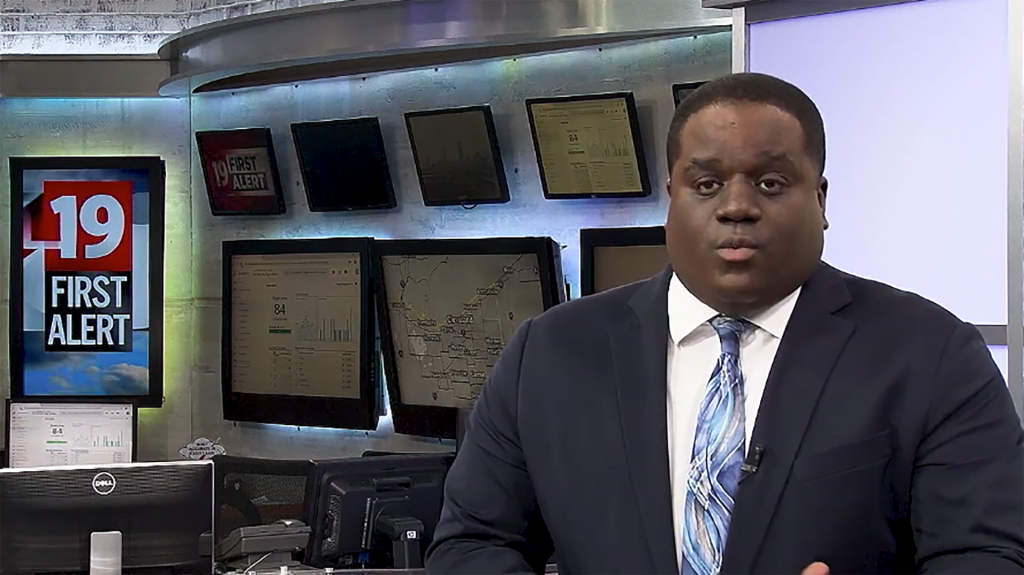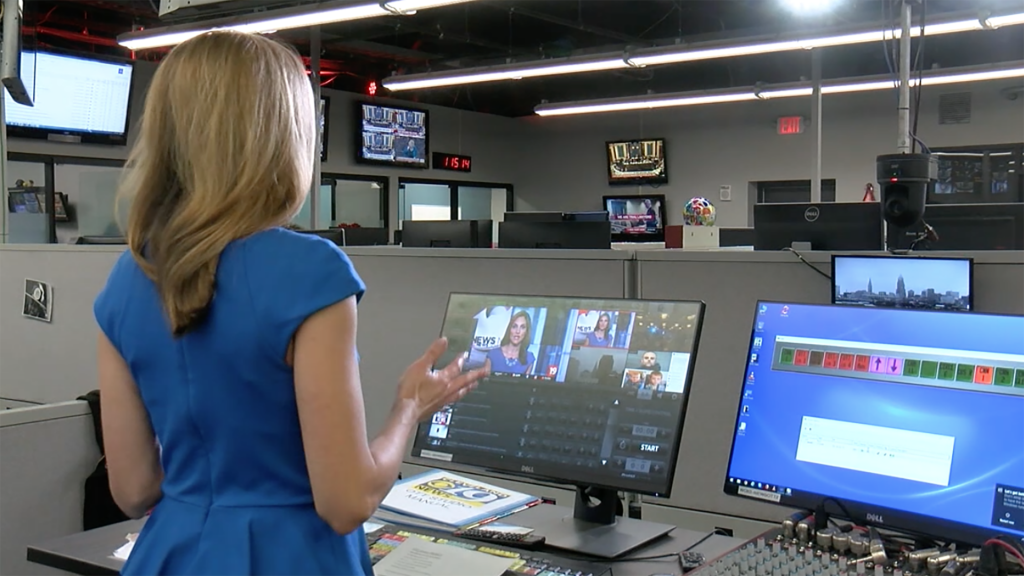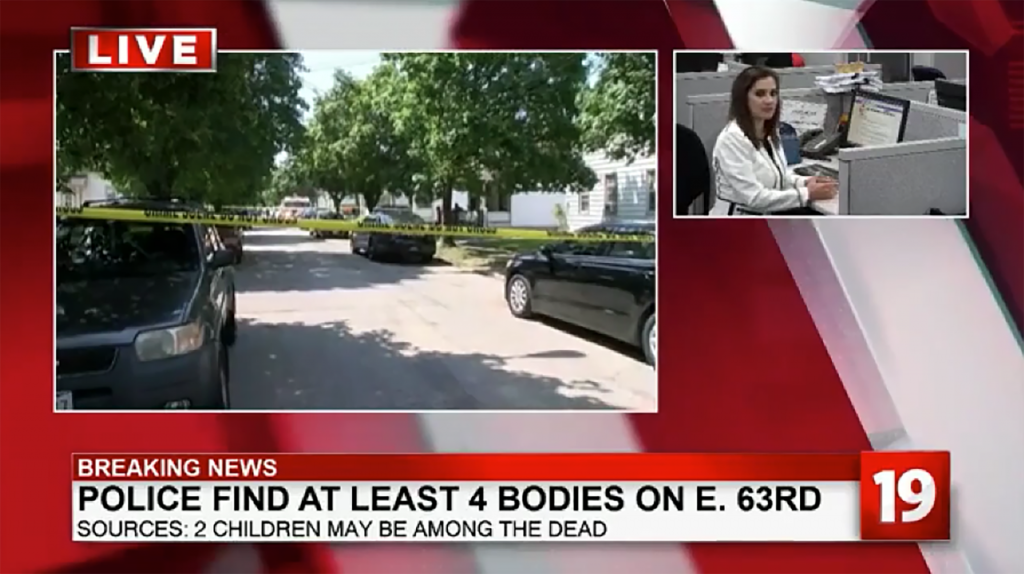
When Cleveland anchor Damon Maloney suddenly has to jump on a breaking story and cover it live on his station’s streaming platforms, he knows he’s in good hands.
His own.
It’s no longer unusual for stations to offer original streaming content. But Gray’s CBS affiliate WOIO-TV is betting that it can make its mark with breaking news on over-the-top (OTT) platforms by adding distinctive elements to its coverage. And the approach relies on technology that puts the talent in the driver’s seat, requiring journalists like Maloney to function as reporter, anchor, producer, director, and executive producer all at the same time. Sounds like a bit of a tough sell, and “it is a lot of work,” says assistant news director Brian Sinclair, but “nobody was resistant, because I think everybody at this point has realized that just doing the newscast is not really going to cut it.”
Maloney and more than half a dozen of his on-air colleagues have been trained to use the JVC ProHD Studio 4000 live production and streaming studio, a “control room in a box” solution that allows the user to go live in about two minutes and add a host of slick production elements, all while conducting interviews and covering an unfolding story. “It was intimidating at first,” admits Maloney, “learning to control the video feeds, the audio, the chyrons while obtaining the information and explaining what’s going on. But once you got behind it, things started to fall into place. As you do it more and more, it becomes more comfortable and actually quite fun, because you kind of control your destiny.” (Every on-air person’s dream!)

Brian Sinclair says he drew inspiration from watching YouTubers use a similar device, the TriCaster. “There were these YouTubers that were doing amazing things sitting in their basement. And I’m like, ‘Why the heck can’t we do that?’” The JVC rig arrived in the newsroom in December of 2018, and now the station uses it multiple times a day, for everything from breaking crime and disaster stories to ongoing trial coverage to the Notre Dame fire in Paris or the latest on the coronavirus.
Like so many other stations, WOIO streams a variety of original content on Roku, Amazon Fire, Apple TV, and YouTube, along with Facebook Live and its own website. And WOIO is not the only Cleveland station to stream live events. But station executives believe that adding the extra elements that the new technology and the training make possible sets their OTT coverage of breaking stories from the newsroom apart. “That’s what’s so wonderful about this OTT platform,” says dayside EP Amanda Harnocz. “We give context to whatever information we just received in the field.”
By its very nature, this type of seat-of-the-pants coverage also fosters a more conversational style and a behind-the-scenes view into the newsgathering process. “I think people like that transparency,” says Maloney. “‘We’re just getting this video in. We don’t have all the answers right now, but this is what we’re working on.’ I think viewers like that because we’re kind of walking them along as we’re seeing it too for the first time sometimes.”
It’s all part of a strategy to attract what Harnocz calls “switchables” — consumers, including younger ones, who are more up for grabs than viewers already locked in to long-standing TV habits. “Social media has changed how we consume news,” says Harnocz. “And ‘switchables’ are the people who are kind of agnostic for content. They don’t care where it comes from, or really what it looks like. They just want to know.” “The digital audience really doesn’t have the loyalties that the television audience has,” agrees Sinclair. “In the digital space, where it’s just all about the content, if you can do better content than your competitors, you’re going to get traction.”

“We’re a station that has to grow,” says news director Ian Rubin. For him, the commitment to OTT breaking news coverage is a way to bolster the station’s image and live up to his tag line “First. Fair. Everywhere.” “It’s part of the mosaic of how we build our brand, build our profile in this market. We’re going to reinforce that we’re the breaking news leader — not just fire and mayhem stories, but in-depth textured stories that take perspective and context to the next level.”
While the station sells spots against its other streaming content, there’s no revenue directly attributable to the breaking news coverage — at least not yet. “The success I don’t think is ever or at least immediately going to be measured just In revenue dollars over OTT or just in viewership over OTT,” says station GM Erik Schrader. “It’s also in that everybody is aware we’re doing this: they know this is a newsroom that’s chasing things every single minute.” That said, while breaking news content is not always sponsor-friendly, Schrader predicts that the station will eventually be able to run commercials in some of the coverage. “As with anything else, when you build an audience, there’s going to be an opportunity for monetization.”

Schrader just showed a highlight reel of the station’s OTT news coverage to a Gray management meeting. “And it was an overwhelming response. I mean, people really see that it’s amazing: you’re getting on with one human being.” He says a newsroom-based live studio operation like his can “easily be done for less than $20,000.”
At the risk of sounding like a cynic, I asked Schrader whether the new technology isn’t just another way to cut costs. He argues that it’s actually a technically and economically feasible way to expand to a new platform without tying up resources devoted to [monetizable] established programs. “If you’re a newsroom, a big part of your content is breaking news, and the ability to get that on and allow all the other heads to continue working towards putting together good broadcast television, and have just one person able to say ‘This right now is what we’re going to be about’ — that’s amazing.”
The low barrier to entry compared to interrupting the network every time there’s “breaking news” — not a realistic option — allows for experimentation and for niche programming, like a 45-minute cut-in on the new head coach of the Cleveland Browns. “We are broadcasters,” says Schrader, “but we all know that the more specific the content can be to someone’s interest, the more passionate that base is going to be.”

WOIO also produces a few original shows specifically for streaming, including a daily Spanish newscast — a mix of original stories and others translated from English — and a weekly cooking show, but “that still leaves us a ton of room to get much more active on this front,” says Schrader. A morning show called Sunny Side Up started as an OTT program but has already “graduated” to the broadcast channel.
“We want to provide value to the viewer, and I think we’re doing that,” says assistant news director Brian Sinclair. “And now it’s how can you make money off of it to make it sustainable in the long term. Especially as linear TV audiences keep dwindling, we’ve got to find a way to get them used to what we’re doing on these platforms. So we’re aggressively trying to find ways to do that.”
At WOIO, going live and solo from the newsroom has become embedded in the daily routine. “Nobody’s nervous about it anymore,” says Sinclair. “Some days it can be a chore, because if you’re doing other things and some annoying person like me comes and grabs you and says, ‘Hey, we have to do this,’ it can be extra work. But for the most part, it is part of the culture. We know what to do, and we do it.”
For his part, anchor Damon Maloney isn’t complaining. “We’ve got to keep evolving to stay alive.”
Tell us about your experiments on streaming platforms at cronkitenewslab@asu.edu.